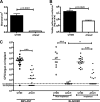Combinatorial small-molecule therapy prevents uropathogenic Escherichia coli catheter-associated urinary tract infections in mice
- PMID: 22733070
- PMCID: PMC3421856
- DOI: 10.1128/AAC.00447-12
Combinatorial small-molecule therapy prevents uropathogenic Escherichia coli catheter-associated urinary tract infections in mice
Abstract
Catheter-associated urinary tract infections (CAUTIs) constitute the majority of nosocomial urinary tract infections (UTIs) and pose significant clinical challenges. These infections are polymicrobial in nature and are often associated with multidrug-resistant pathogens, including uropathogenic Escherichia coli (UPEC). Urinary catheterization elicits major histological and immunological alterations in the bladder that can favor microbial colonization and dissemination in the urinary tract. We report that these biological perturbations impact UPEC pathogenesis and that bacterial reservoirs established during a previous UPEC infection, in which bacteriuria had resolved, can serve as a nidus for subsequent urinary catheter colonization. Mannosides, small molecule inhibitors of the type 1 pilus adhesin, FimH, provided significant protection against UPEC CAUTI by preventing bacterial invasion and shifting the UPEC niche primarily to the extracellular milieu and on the foreign body. By doing so, mannosides potentiated the action of trimethoprim-sulfamethoxazole in the prevention and treatment of CAUTI. In this study, we provide novel insights into UPEC pathogenesis in the context of urinary catheterization, and demonstrate the efficacy of novel therapies that target critical mechanisms for this infection. Thus, we establish a proof-of-principle for the development of mannosides to prevent and eventually treat these infections in the face of rising antibiotic-resistant uropathogens.
Figures




Similar articles
-
Selective depletion of uropathogenic E. coli from the gut by a FimH antagonist.Nature. 2017 Jun 22;546(7659):528-532. doi: 10.1038/nature22972. Epub 2017 Jun 14. Nature. 2017. PMID: 28614296 Free PMC article.
-
Treatment and prevention of urinary tract infection with orally active FimH inhibitors.Sci Transl Med. 2011 Nov 16;3(109):109ra115. doi: 10.1126/scitranslmed.3003021. Sci Transl Med. 2011. PMID: 22089451 Free PMC article.
-
Antivirulence Isoquinolone Mannosides: Optimization of the Biaryl Aglycone for FimH Lectin Binding Affinity and Efficacy in the Treatment of Chronic UTI.ChemMedChem. 2016 Feb 17;11(4):367-73. doi: 10.1002/cmdc.201600006. Epub 2016 Jan 26. ChemMedChem. 2016. PMID: 26812660 Free PMC article.
-
Rational design strategies for FimH antagonists: new drugs on the horizon for urinary tract infection and Crohn's disease.Expert Opin Drug Discov. 2017 Jul;12(7):711-731. doi: 10.1080/17460441.2017.1331216. Epub 2017 Jun 2. Expert Opin Drug Discov. 2017. PMID: 28506090 Free PMC article. Review.
-
Developments in Mannose-Based Treatments for Uropathogenic Escherichia coli-Induced Urinary Tract Infections.Chembiochem. 2021 Feb 15;22(4):613-629. doi: 10.1002/cbic.202000406. Epub 2020 Nov 2. Chembiochem. 2021. PMID: 32876368 Free PMC article. Review.
Cited by
-
Positively selected FimH residues enhance virulence during urinary tract infection by altering FimH conformation.Proc Natl Acad Sci U S A. 2013 Sep 24;110(39):15530-7. doi: 10.1073/pnas.1315203110. Epub 2013 Sep 3. Proc Natl Acad Sci U S A. 2013. PMID: 24003161 Free PMC article.
-
Biofilm-related infections: bridging the gap between clinical management and fundamental aspects of recalcitrance toward antibiotics.Microbiol Mol Biol Rev. 2014 Sep;78(3):510-43. doi: 10.1128/MMBR.00013-14. Microbiol Mol Biol Rev. 2014. PMID: 25184564 Free PMC article. Review.
-
Dihydrothiazolo ring-fused 2-pyridone antimicrobial compounds treat Streptococcus pyogenes skin and soft tissue infection.bioRxiv [Preprint]. 2024 Jan 3:2024.01.02.573960. doi: 10.1101/2024.01.02.573960. bioRxiv. 2024. Update in: Sci Adv. 2024 Aug 2;10(31):eadn7979. doi: 10.1126/sciadv.adn7979. PMID: 38260261 Free PMC article. Updated. Preprint.
-
Role of Klebsiella pneumoniae type 1 and type 3 fimbriae in colonizing silicone tubes implanted into the bladders of mice as a model of catheter-associated urinary tract infections.Infect Immun. 2013 Aug;81(8):3009-17. doi: 10.1128/IAI.00348-13. Epub 2013 Jun 10. Infect Immun. 2013. PMID: 23753626 Free PMC article.
-
Urinary tract infections: current and emerging management strategies.Clin Infect Dis. 2013 Sep;57(5):719-24. doi: 10.1093/cid/cit284. Epub 2013 May 3. Clin Infect Dis. 2013. PMID: 23645845 Free PMC article. Review.
References
-
- Alton G, Kjaergaard S, Etchison JR, Skovby F, Freeze HH. 1997. Oral ingestion of mannose elevates blood mannose levels: a first step toward a potential therapy for carbohydrate-deficient glycoprotein syndrome type I. Biochem. Mol. Med. 60:127–133 - PubMed
-
- Anderson GG, et al. 2003. Intracellular bacterial biofilm-like pods in urinary tract infections. Science 301:105–107 - PubMed
-
- Bi XC, et al. 2009. Pathogen incidence and antibiotic resistance patterns of catheter-associated urinary tract infection in children. J. Chemother. 21:661–665 - PubMed
Publication types
MeSH terms
Substances
Grants and funding
LinkOut - more resources
Full Text Sources
Other Literature Sources
Medical
Molecular Biology Databases

